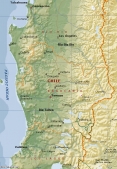Araucanian / Mapuche – A Brief Guide of the Language

Posted on April 9, 2014 by Chris
Araucanian is a language isolate. It shares no common traits with other languages, and it is therefore concentrated to a minority population. It is spoken in central Chile and neighbouring areas of Argentina.
Although some translation experts have claimed to have demonstrated a relationship between Araucanian and other languages, Araucanian is really rather unique.
Araucanian was a name actually given to the Mapuche language (also spelt Mapuzugun and sometimes called Mapudungu) by the Spanish. Native speakers are offended by the name Araucanian, as it is a remnant of Spanish colonialism. Prior to Spanish colonialism, there was no written form of Mapuche. It is only after the Spanish arrived that the language adopted one, which uses the Latin script. There is no universal written form of the language, though.
The language originates from South American Indians, as far as history can tell. It was first discovered around 1536 when the first Spanish soldiers encountered the population. The first Mapuche speakers encountered by the Spanish were the Picunche (a region distinguished by the Spanish), who lived in the north between the Choapa and Biobío rivers. Assimilation between the Spanish and Picunche over 200 years put the Picunche into poverty.
They were for all intents and purposes a peasant population, and lived separate to Spanish settlers.
Other Araucanian populations geographically included the Mapuche inhabiting the middle valleys, and the Huilliche inhabiting in the south. The Mapuche were not tolerant of outsiders, and over the course of 200 years, there were several battles between soldiers. Over time, however, the two peoples did work together to settle their differences, but tensions do still remain.
Today, Araucanian languages are common in central Chile and neighbouring areas of Argentina, but outside of there it is rarely spoken, if at all.
It is estimated that the number of Mapuche language speakers is between 240,000 and 700,000. It is rare, however, to find an individual that speaks Mapuche as a first language – most people speak Spanish.
The language itself does have several dialects. In Chile, there are a number of variations spoken, although all share common words and grammar, just like Austrian and German.
The two living branches of Araucanian are Huilliche and Mapudungun. Due to the educational system in Chile and Argentina, the language does not benefit from any significant budget or support.
As such, teaching of the language takes place in the community, commonly from elders.




